
Lotus Esprit 350
Autocar Road test
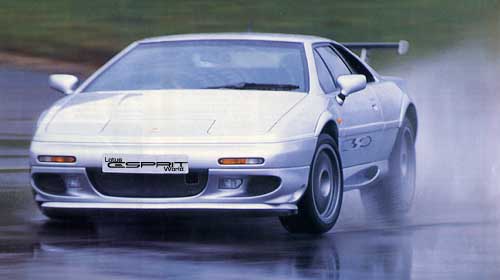
| MODEL TESTED Sport 350 | ON ROAD PRICE £64,950 |
| TOP SPEED 175mph (claimed) | 30-70MPH 3.9sec |
| 0-60MPH 4.7sec | 60-0MPH 3 2sec |
| MPG 16.3 | ratings out of five (•) |
| FOR Blindingly quick, road racer looks, huge dry-road grip | AGAINST Ride is too stiff, poor gearchange, cramped cabin |
For a company whose core reputation has been sculpted around lightweight, high-tech fast cars, the Esprit Sport 350 appears to represent something of an ultimate achievement for Lotus.
Developed from the already awesomely rapid V8 road car but encapsulating much of the brake, suspension and handling technology gleaned from two decades of GT competition experience, the Sport 350 is, in Lotus's own words, ''the most extreme version of the Esprit ever to reach the market''.
It is also, in our words, the most outrageous, visually as well as financially - not to mention the most exclusive. In total Lotus will construct just 50 cars, all of which will be offered in the same silver/grey/blue colour scheme as worn by the £66,135 test car.
Yet despite the extra drama created by the huge carbon fibre rear wing and the new OZ Racing alloy wheels, the Sport 350 is little changed beneath the skin compared with the ordinary V8, bar its stiffer suspension, bigger brakes and a minor increase in torque in the lower gears. Its power output is exactly the same at 349bhp, although the 80kg reduction in weight is claimed to make this the most accelerative Esprit in history, if not the lightest overall.
The real question is: is it also the best?

DESIGN & ENGINEERING
Lotus may claim that the Sport 350 is the most extreme Esprit in history but in truth it is little changed mechanically from the regular V8. Beneath the rear deck lurks what is fundamentally an unmodified version of Lotus's 32-valve twin-turbo 3.5-litre V8, the only difference being a mild increase in torque in the first three gears due to different mapping of the ECU system. Peak power is unchanged at 349bhp. with 2951b ft of torque arriving at the same 4250rpm. The Renault-designed five-speed gearbox is also unaltered.
Other than the changes to the suspension and brakes, it is therefore down to the visual aids to distinguish the Sport 350 from lesser Esprits, a task in which Hethel's bold stylists will no doubt have revelled.
The most dramatic difference is the new rear wing, surely the most outrageous yet seen on a road car. It's actually a close relative of the carbon fibre wing worn by the Type 115 GT racer and is mounted on gorgeous aluminium uprights for the pukka road racer effect.
At the nose there's a deeper opening, providing the front end with even greater menace when viewed head on. while nestling within each wheel arch is a purposeful-looking OZ Racing alloy wheel wearing fat Pirelli P-Zero rubber.
Ultimately, however, it's what sits behind the wheels that really sets the 350 apart from other Esprits. Up front, four-pot AP Racing calipers chomp on 320mm discs, while at the back there are similarly vast discs with two-pot calipers, not to mention a bespoke Kelsey Hayes anti-lock system. At last, it seems. Lotus has addressed the Esprit's painfully obvious braking problems.
All Sport 350s get the same grey paint scheme in which blue streaks appear in the nose, along the side cooling ducts and on the Sport 350 decals on the doors and roof. The blue theme continues inside with the Alcantara/leather bucket seats. There are also tasteful splashes of carbon fibre and aluminium around the gear lever and centre console that provide a much-needed visual lift to the cabin.
Lotus breathes a little new life into an ageing design •••
PERFORMANCE/BRAKES
It would be easy to take one look at the acceleration figures that accompany this road test and dismiss the Sport 350 as being no more than competitive in a straight line relative to other £65,000 supercars. After all, the regular V8 rocketed to 60mph in 4.2sec and to 100mph in 10.3sec in 1996. In both instances, those times appear to eclipse the 350's performance of 4.7sec and 10.7sec - disappointing, as the 350 uses the same engine and gearbox yet weighs 80kg less.
But there's one redeeming factor to consider in this instance: the fact that the 350 was timed when it was streaming wet, unlike the V8 of three years ago. This alone makes the 350 blindingly fast, even by Esprit standards.
To duck below 5.0sec to 60mph and 11sec to 100mph in the pouring rain is loosely the equivalent of going sub-4.0sec to 60mph and below 10sec to 100mph in the dry. Which means that in reality only the mighty TVR Cerbera goes quicker for less money, and that's before we've stirred in the 350's most pungent ingredient: its in-gear acceleration.
Admittedly there's a short pause in the high gears where not a lot happens when the throttle is opened sharply at low revs, but the instant the needle rises past 1800rpm you can feel and hear the two Garrett turbos go to work on the 3.5-litre V8.
By 2000rpm it depends largely on what gear you're in as to whether the acceleration is strong, savage or eye-popping; witness the incredible 50-70mph top-gear time of 5.8sec, nearly 2.0sec inside a BMW M3 despite the fact that the engine is yet to get fully into its stride by then. Drop to third and this same increment takes a scarcely credible 2.6sec, putting the Sport 350 on level terms with all but the fastest superbikes and, therefore, comfortably ahead of most four-wheeled rivals. By any standards it is a ferociously; addictively fast car.
What a pity, then, that the performance is by and large so unpleasant to access. A recalcitrant gearchange means swopping cogs is not the joyful experience it should be. Worse still, the flat-crank engine sounds coarse and totally uninspiring when extended. This particular example also seemed to suffer from spurious vibrations in the mid-range that did nothing to enhance the impression of mechanical refinement. As with previous Esprit V8s we've tried, the engine is let down by its personality, not by its ultimate outputs.
However, Lotus does seem to have solved the Esprit's braking problems. The big AP calipers snatch a little when cold, but generally they're well up to the job, hence the superb wet-weather 60-0mph time of 3.2sec.
Very quick but needs more charisma. Good brakes at last ••••
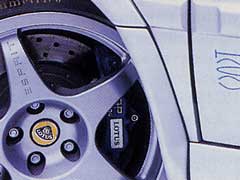
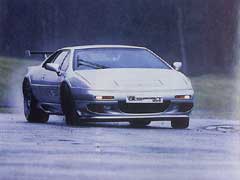
HANDLING & RIDE
There have always been certain things that separate an Esprit's handling and ride from that of its rivals. They usually involve its steering, its composure over rough roads and its balance on or around the limit of adhesion.
Take these aspects away, however, and the Esprit would not be the handling legend it is today. That makes it hard to understand exactly who Lotus sees the hard-riding and uncharacteristically uncompromising Sport 350 appealing to.
Even the regular V8 struggles to offer the sort of soothing ride and steering responses that so distinguish the lesser GT3 model from its stablemates, but by equipping the Sport 350 with even stiffer Eibach springs, not to mention wider tyres, Lotus has ended up worsening rather than improving the V8's lot, certainly as far as its handling ability on the road is concerned.
But then this may not be entirely fair to the designers of the Sport 350. For if, as Lotus claims, this car has been designed to appeal to a small band of people who intend to drive on race tracks a lot and use their car only occasionally on the road, then it makes good sense. Ultimate grip levels are indeed higher than normal and body roll has been significantly decreased. There's also a fair bit more composure over long-wave, high-speed undulations. That extra control would hardly affect a car on the road but is vital on a circuit, where speeds are higher.
Trouble is, good track cars rarely make good road cars and vice versa. Indeed, when it comes to the more delicate aspects of chassis behaviour it often works in reverse, and the 350. we're sorry to admit, is a not-so-shining example of this.
Compared with mere mortal supercars, its power steering is still beautifully crisp and precise, but it has gained some unwanted rim kickback over rough roads. plus an over responsive quality just off centre, that will prove an unwelcome surprise to regular Esprit drivers.
Equally, the chassis is now pretty much incapable of absorbing a badly pockmarked British B-road. The fat Pirelli P-Zero tyres (235/40 ZR17s up front, 295/35 ZR18s at the back) now smack down heavily into ruts and are easily knocked off course, which means you end up having, to drive as you would in normal supercars, having to spot and steer around obstacles. Previously you'd just drive straight at them in an Esprit and allow the suspension to sort the rest out.
Better on a track than it is on road due to stiff springs ••••
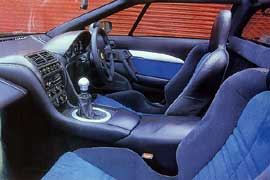
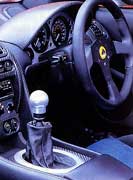
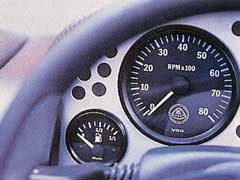
COMFORT, EQUIPMENT & SAFETY
Climbing aboard the Sport 350 is, as with any Esprit, a uniquely taxing physical experience, with small door openings and wide sills. In fact, entry and egress are more awkward than ever because the 350's part leather, part-Alcantara bucket seats are mounted fractionally lower in the chassis.
Once ensconced behind the new non-adjustable non-airbag Momo wheel, you quickly realise that the driving position, though marginally improved thanks to the narrower transmission tunnel, remains fundamentally flawed. The pedals are still ludicrously offset towards the centre of the car, while the footwell itself is as cramped as ever. And although the extra-high rear wing has improved rear vision slightly; overall the cabin is not well laid out, even though most of the instruments are now visible from behind the wheel, which wasn't the case before last year's reasonably successful interior rethink.
Nevertheless, there are signs that Lotus has tried hard to distinguish the 350's cabin from that of lesser Esprits, some of which are more convincing than others. The new seats, once you've squeezed your way into them, hold most frames like a vice and provide terrific support when you're pressing on.
Equally impressive is the attention to detail around the gear lever and centre console, where genuine carbon fibre and a mixture of blue Alcantara and bare aluminium have been used to great effect to lift the overall cabin atmosphere. The result is that the 350 has a unique quasi-racer feel inside.
Less convincing is the drop-off in mechanical refinement compared with other Lotuses. The alterations to the chassis have done as much to harm the Esprit's ability to cover long distances in comfort as they have for its ride and handling, and the upshot is that the 350 is not a happy motorway cruiser due to its extra tyre roar and suspension rumble.
There was a time when Lotus build quality did not have to be examined too closely before the flaws began to emerge, but the 350 heightens the turnaround in quality control heralded by the Elise. By and large it is well enough assembled to stand comparison against any similarly priced rival, the paint. panel gaps and carpet finish all being beyond serious criticism.
Indeed, our only complaints in this area concern the lack of a passenger's airbag and the relegation of air conditioning to the options list.
Cabin is cramped but characterful. Well made, too •••
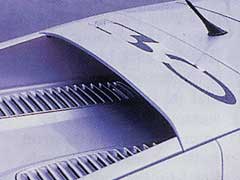
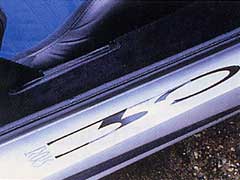
ECONOMY
One of the most surprising aspects of the Sport 350's fuel consumption is not that it drops below 16mpg when thrashed or that it can be made to eke almost 22 miles out of every gallon when stroked, but rather that it does not require super unleaded to give of its best. Often with cars of this ilk the engine will not run properly unless it's fed with 98-octane fuel, but in this instance the Hethel V8 musters just as much fury on regular 95-octane unleaded as it does on 98.
Driven gently, it will run for about 350 miles between fills - not bad for a 170mph supercar.
Marginally better than average for a 170mph supercar •••

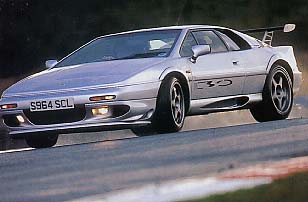
MARKET & FINANCE
It'll be a bold, not to mention wealthy, individual who takes the plunge and spends the full £64,950 on a brand new Esprit Sport 350. The fact that supply is guaranteed by the factory to be limited to a run of just 50 cars will no doubt help bolster the residual values to a certain extent in the short term, but the basic truth remains that Esprits don't hold their value as well as other similarly priced supercar rivals over the longer term. Compared with the Porsche 911 Carrera, for example, its value will drop like a stone over five to eight years.
The dealer market is also slightly misleading in that cars are often advertised at prices rather higher than the vendor is ultimately prepared to sell for, so make sure you haggle, even on brand new examples.
Don't expect the Sport 350 to be anything other than expensive to run in terms of servicing and insurance. Having said that, garage bills have dropped markedly compared with the more labour-intensive four-cylinder Esprits.
Watch out for long-term residuals, they could tumble •••
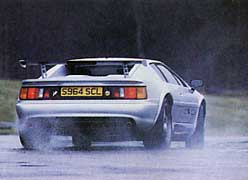
Autocar Verdict
It's an odd tool, the Esprit Sport 350. Having been delighted by so many examples of Hethel's enduring mid-engined supercar over the years, you naturally tend to know what to expect from any new example that happens along: same poor driving position, same notchy gearchange, same dreadful rear visibility; same unrivalled ability to paint a smile across your face over a great road due to the unique blend of ride, handling, steering and straight-line performance.
Most of the raw ingredients are present in this latest version. Indeed, from a pure performance point of view the ingredients are more vivid than they have been at any time in the Esprit's 22-year history. From a styling standpoint, too, this has to be the most dramatic, if not perhaps the prettiest incarnation of the car that not once but twice did the business for our James Bond in the '70s and '80s.
Back in those days, although the Esprit looked like a renegade from a Le Mans paddock, its intentions as a road car were as sharply defined as the angular extremities of its Giugiaro-designed body. It was a road car, pure and simple, a role to which it has remained true - right up until now.
For whatever reason, Lotus has attempted to blur the boundaries between supercar and racing car with the Sport 350, creating in the process what it defines as the most focused development ever of the Esprit. But we'd dispute that.
Yes, the 350 is focused in as much as it has one of the most attractive, well-made interiors ever to grace an Esprit. And with its vast rear wing, aggressive chin spoiler and bespoke paintwork, it also looks like it should be more of a riot than any other Esprit.
Yet in truth Lotus has gone too far with the Sport 350, particularly with its uncompromising suspension and steering. And the trouble is, without the usual soothing ride, forgiving handling and gorgeous steering it becomes more difficult to be tolerant of the flaws. Even the V8 engine starts to seem less impressive in the event.
We tried hard to adore this car in the way we've adored most other Esprits, but in the end even Hethel, it seems, can make mistakes.
Esprit V8 goes over the top •••
Notes
All 50 Sport 350s will be fitted with a limited edition aluminium plaque at the base of the windscreen me the centre of the dash.The test car was No.1 in a batch that will take most of this year to complete. Although the engine of the Sport 350 is fundamentally identical to that of the regular V8 engine of the basic Esprit V8. the cam covers me painted blue, not red. There's also a brace across the top of the engine bay to provide extra rigidity when owners lake to the track. The styling was influenced heavily by the X18OR GT racing Esprit that won the IMSA championship earlier this decade.
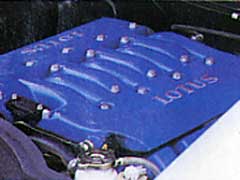
Specification
ENGINE
Layout: 8 cyls in a vee, 3500cc
Max power: 349bhp @ 6500rpm
Max torque: 295lb ft @ 4250rpm
Specific output: 100bhp per litre
Power to weight: 268bhp per tonne
Torque to weight: 227lb ft per tonne
Installation: Mid longitudinal, rear-wheel drive
Construction: Aluminium alloy head/block
Bore/stroke: 81.0/83.0mm
Valve gear: 4 valves per cyl, dohc
Compression ratio: 8.0:1
Ignition and fuel: Lotus 918 ignition, multi-point injection, twin
Garrett T25 turbochargers
GEARBOX
Type: 5-speed manual
Ration/mph per 1000rmp
1st 3.36/5.5 2nd 2.05/9.0 3rd 1.38/13.4
4th 1.09/17.9 5th 0.76/25.5
Final drive ratio: 3.89
MAXIMUM SPEEDS
5th 175mph/6850rpm (claim) 4th 129/7200
3rd 96/7200 2nd 65/7200 1st 40/7200
ACCELERATION FROM REST
SURFACE WET
| True mph |
sec
|
speedo
mph
|
| 30 |
2.1
|
33
|
| 40 |
2.8
|
43
|
| 50 |
3.8
|
53
|
| 60 |
4.7
|
62
|
| 70 |
6.0
|
73
|
| 80 |
7.5
|
84
|
| 90 |
8.8
|
94
|
| 100 |
10.7
|
105
|
Standing qtr mile: 13.0sec/109mph
Standing km: 22.8sec/142mph
30-70mph through gears: 3.9sec
ACCELERATION IN GEAR
| mph |
5th
|
4th
|
3rd
|
2nd
|
| 10-30 |
–
|
–
|
4.6
|
2.6
|
| 20-40 |
8.9
|
5.4
|
3.6
|
2.0
|
| 30-50 |
8.0
|
4.4
|
2.9
|
1.7
|
| 40-60 |
7.3
|
3.9
|
2.5
|
–
|
| 50-70 |
5.8
|
3.4
|
2.6
|
–
|
| 60-80 |
5.3
|
3.3
|
2.9
|
–
|
| 70-90 |
5.6
|
3.5
|
3.2
|
–
|
| 80-100 |
6.1
|
3.7
|
3.5
|
–
|
SUSPENSION
Front: Double wishbones, coil springs over dampers, anti-roll
bar
Rear: Upper and lower links, coil springs over dampers, anti-roll bar
WHEELS & TYRES
Wheel size: 8.5Jx17in (f), 10Jx18in (r)
Made of: Forged alloy
Tyres: 235/40 ZR17 (f), 295/35 ZR18 (r)
Pirelli P-Zero Spare: Full size
BRAKES
Front: 320mm cross-drilled ventilated discs
Rear: 320mm cross-drilled ventilated discs
STEERING
Type: Rack and pinion, power assisted
Turns lock to lock: 3.1
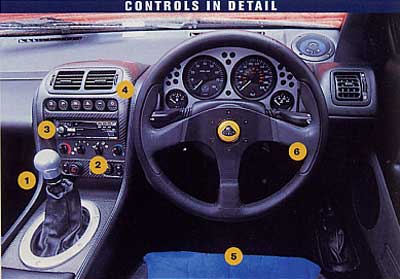
1 Aluminium gear knob is freezing on cold mornings; gearshift not a strong point 2 Air conditioning costs £1185 extra 3 Alpine stereo is much improved 4 Carbon fibre is used extensively; it's the real thing, too 5 Seats are partly covered in grippy Alcantara 6 Sport 350 buyers can choose between airbag wheel or this Momo item at no extra cost
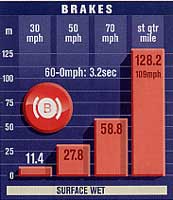
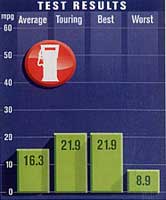
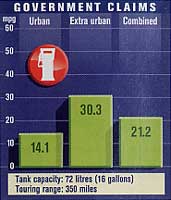
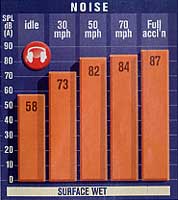
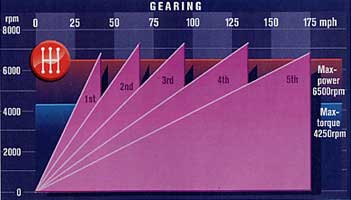
Body 2rd coupe Cd n/a Front/rear tracks 1520/1520mm Turning circle 10.6m Min/max front leg room 1060/1250mm
Max front head room 880mm Interior width 1430mm Min/max boot width 1240/1870mm Boot height 280mm
VDA Boot volume n/a Kerb weight 1300kg Weight distribution front/rear 43/57 per cent Max payload 227kg
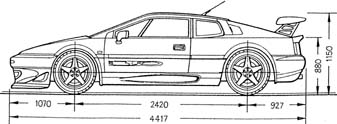
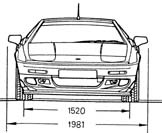

The performance figures
were taken with the odometer reading 1870 miles.
AUTOCAR test results are protected by world copyright and may not be reproduced
without the editor's written permission
|
|